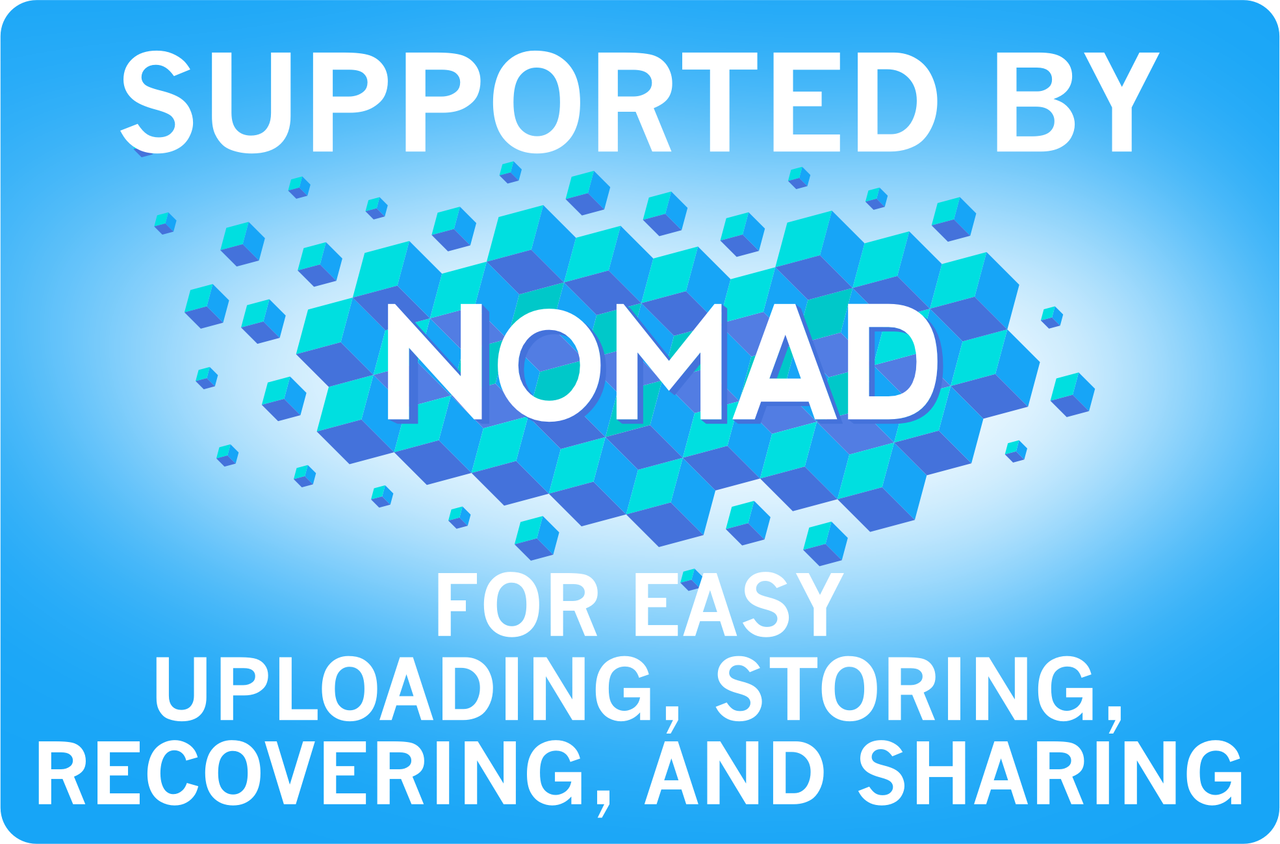Introducing CRYSTAL17
The functionalities of the latest major version of the program, CRYSTAL17, are illustrated in a Review recently published on WIREs Comput Mol Sci, that can be found at: http://dx.doi.org/10.1002/wcms.1360
Users are kindly requested to cite this reference when publishing their results obtained with CRYSTAL17.
CRYSTAL17 (v1.0.2)
The CRYSTAL Team is pleased to announce the release of CRYSTAL17 v1.0.2 (released on 19/04/2018). Version 1.0.2 is mainly a bugfix release. All users are encouraged to upgrade to v1.0.2 as soon as possible.
The main novelties in the new v1.0.2 version of CRYSTAL17 are:
- Two new composite DFT methods, HSE-3c, B97-3c, are available.
- Analytical forces (gradients) for the geometrical Counterpoise (gCP) method and the SRB correction (used in HF-3c and B97-3c) are now available.
- The code for DIIS accelerator has been improved in terms of efficiency (with average speedups of about 8% on routine calculations).
- A different algorithm is now used for solving the DIIS equation. As a consequence, small numerical discrepancies with respect to v1.0.1 might be observed.
- A bug in the LSRHS-PBE functional has been fixed;
- A bug arising in the ATOMINSE keyword eventually inserting ghost atom has been fixed;
- A bug in the construction of some super-cells for phonon dispersion calculations has been fixed;
- The FDAOSYM option for analyzing the partial occupation of d- and f-type orbital shells has been restored;
- A bug in the internal guess of the density matrix of low-symmetry systems for self-consistent hybrid functionals has been fixed;
- Elastic calculations with the gCP correction and composite methods have been enabled;
- The MULTITASK option for task-farming in harmonic frequency calculations has been restored;
- The use of the FDOCCUP option to force a desired partial occupation of d- and f-type orbital shells has been made available also for elastic and equation-of-state calculations;
- A default temperature range has been introduced in quasi-harmonic approximation calculations;
- Printing of hyperpolarizabilities in output has been improved.
Obituary - Victor Ronald Saunders (1943-2018)
A chemist who applied his brilliance to the quantum chemistry of solids.

Vic was born in the north west of England at Birkenhead in April 1943. He received his Grad. R.I.C. in 1965 and moved to the University of Sussex for his post-graduate work. In 1969 he joined Professor Ian Hillier’s group in the Department of Chemistry at Manchester University as a Research Fellow. He left in 1971 to become a Senior Scientific Officer within the Atlas Lab. at the Rutherford Appleton Laboratory in Oxfordshire. There he remained until in the early 1980s he and his colleagues moved to Daresbury Laboratory in Cheshire where he remained until his retirement in 2003.
In 1980 Vic had met with Cesare Pisani, Carla Roetti and Roberto Dovesi from the theoretical chemistry group at the University of Torino, who had started in 1976 to code the CRYSTAL code, using a Gaussian basis set and the Hartree-Fock Hamiltonian for investigating periodic systems. The Torino group was looking for expertise and skill for generalizing and enriching the possibilities of the CRYSTAL code. In less than one year Vic inserted a new Gaussian integral package for s, p and d integrals (later on, around 2000, he extended this to f orbitals, and prepared tables for a further extension to g), and a very effective multipolar expansion for treating the Coulomb series. This was the beginning of the great collaboration of Vic’s career that led to the development and distribution of the CRYSTAL software for applying quantum theory to solid state chemistry. For about 25 years Vic was a sort of “guardian of the temple” for the CRYSTAL code, looking, cleaning and improving the code line by line, making it robust to any translation (from operating system to operating system, compiler to compiler, architecture to architecture). A sort of continuous, day by day monastic activity that made in these years the code solid as a Roman Bridge. In parallel he was introducing many new features in the code. Parallelization of the integral packages, direct strategies, and many others. Three in particular are worth of mention: the treatment of the infinite Coulomb series for 3D systems through very efficient recursion relations (Mol. Phys. 77, 629, 2002; extension to 1D appeared 2 years later; the 2D case has never been published); the generation of well localized Wannier functions (with Claudio Zicovich, coded in these years but published only in 2000: one of Vic’s characteristics is that he was interested in solving problems, not so much to share the solution through publications, as the “next” problem was calling); the implementation of a very accurate strategy for the integration of the DFT exchange correlation term in the Fock Hamiltonian.
In 1986 Nicholas Harrison joined Vic at Daresbury Laboratory and forming a close collaboration they developed and applied quantum theory in the CRYSTAL code to problems in strongly correlated condensed matter. The realisation that Fock exchange was key to the self-interaction error in density functional theory allowed them to unravel many long standing problems in electronic structure and magnetism.
During these years Vic was extremely useful in the preparation of the various public releases of the CRYSTAL code (1992, 95, 98, 2003), as he was incredibly quick to grasp error, inconsistencies, dangerous coding. He also attended many CRYSTAL schools held in Torino and London for the education of young scientists: Always sharp, clear, effective (and sometimes a bit dangerous: he was able to explore challenging problems through a few lines of equations, so that lectures often were ended after say 25 minutes instead of 45, and the Chairman had to look in a hurry for the next speaker).
In 2003 Vic retired, the event was celebrated in a meeting held in Daresbury on the 9th June of that year. In the following years he continued to visit the Torino group (he had become an honorary member of the Chemistry Dept. there). In the Autumn of 2005 he suffered a transient ischeamic attack that stopped his, still very brilliant, scientific activity.
Those of us who worked closely with Vic are forever in his debt for being able to share in his remarkable ingenuity, intelligence, generosity of spirit and, perhaps more than anything else, his ability to focus, to the exclusion of all else, on a scientific problem until it was solved.
He will be sorely missed.
CRYSTAL Tutorials: web site restyling
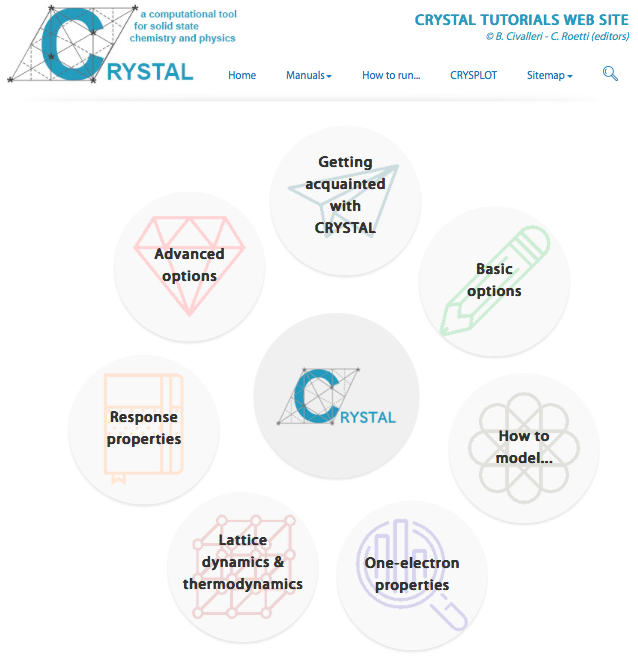
We are very grateful to Giorgia Beata and Gianpaolo Perego (Crystal Solutions - Aethia s.r.l.) for their invaluable work in the editing and restyling of the web site.
CRYSTAL on the cover
The massively parallel version of the CRYSTAL17 program has recently been presented on a paper entitled “Large Scale Condensed Matter DFT Simulations: Performance and Capabilities of the CRYSTAL Code” [J. Chem. Theory Comput., 13, 5019-5027 (2017)]
The performance of the code in terms of parallel efficiency, speed-up and memory distribution attracted the attention of the Editors of the Journal who decided to highlight the study on the cover of the October 2017 issue.
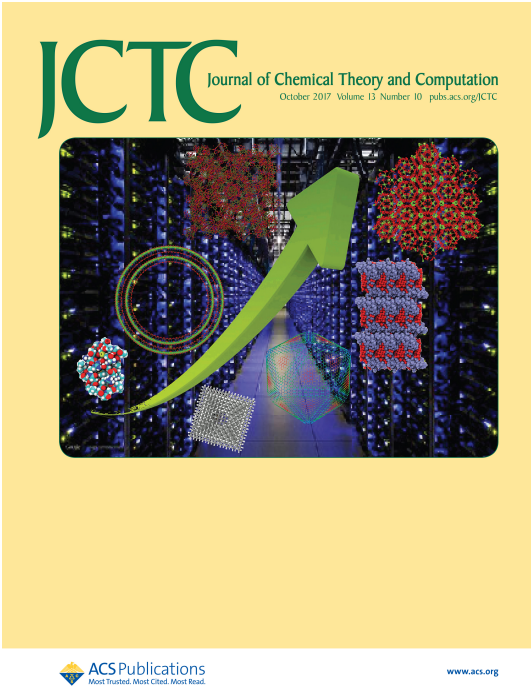
The effective exploitation of high-performance computing (HPC) resources allows for extending the application domain of quantum-mechanical simulations towards the study of large, chemically- and structurally-complex systems. The massively parallel version of the CRYSTAL program for condensed matter applications is shown to run and scale efficiently up to 32,000 cores on HPC architectures for the study of systems containing up to 14,000 atoms per cell.
In 2015, the parallelization of the program module for the evaluation of one-electron properties of solids has been presented on a paper entitled “Electron Density Analysis of Large (Molecular and Periodic) Systems: A Parallel Implementation.” [J. Comput. Chem., 36, 1940-1946 (2015)]. Also in that case the Editors decided to highlight the study with the cover of the September 2015 issue.
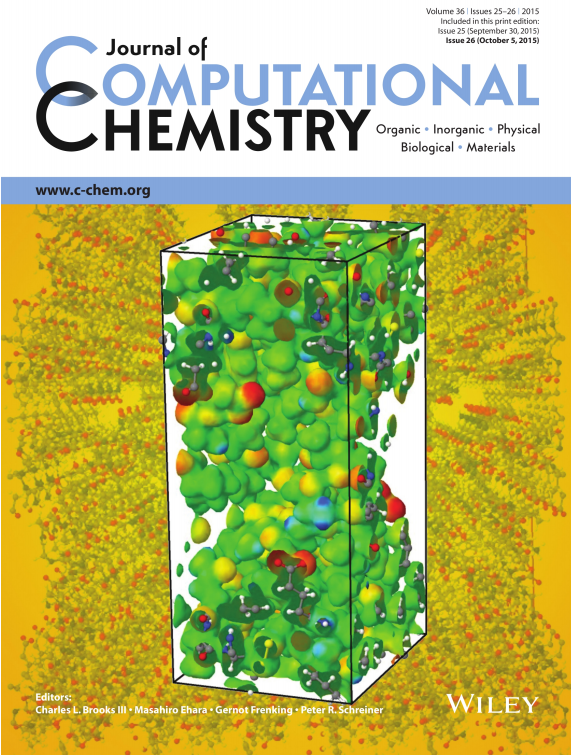
The authors present a parallel implementation of a series of algorithms for the analysis of the electron density (both in position and momentum spaces) of large molecular and periodic systems, as obtained from ab initio calculations with the CRYSTAL14 program. Bader's topological analysis, electron charge and momentum densities, electrostatic potential, X-ray structure factors, and directional Compton profiles are among the properties which can be computed at reduced wall-clock time by exploiting the high speed-up due to parallelization over orbital-shell pairs. The crystallized Crambin protein (containing as many as 1284 atoms per unit cell) is taken as a test-case.
The paper has been highlighted on the cover of the August 2014 issue.
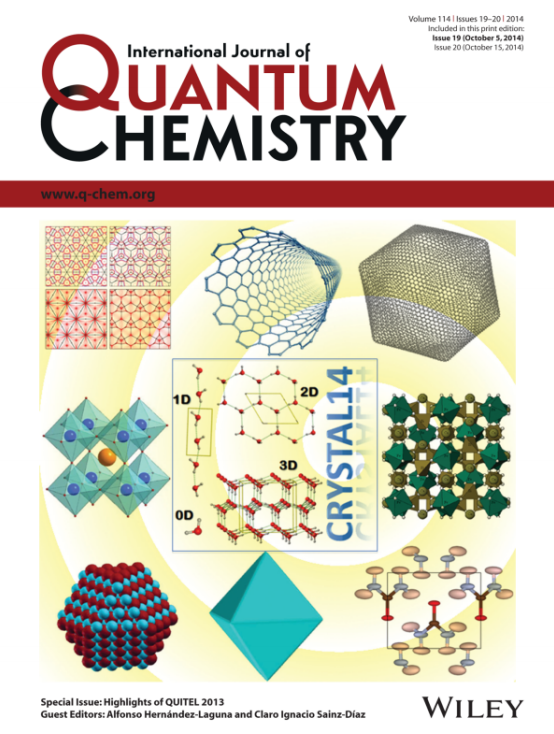
The authors report on CRYSTAL, a general-purpose ab initio periodic program for the study of crystalline solids. CRYSTAL computes the properties of periodic systems within Hartree- Fock, density functional or various hybrid approximations. Systems of any periodicity can be treated by exploiting their symmetry at all calculation steps. The newest program version, CRYSTAL14, has recently been released and its new features are here presented. New capabilities and enhancements are discussed along with selected applications and performance benchmarks.
CRYSTAL17
The new version of CRYSTAL is available and can be downloaded from the CRYSTAL solutions web site
The CRYSTAL Team is pleased to announce the release of CRYSTAL17 (current version: v1.0.1).
CRYSTAL17 is a major release and the most relevant new features are:
- Implementation of the DIIS convergence accelerator (set as a default) for the SCF and CPHF/KS (first- and second-order) self-consistent procedures
- Implementation of a fully-automated scheme for the evaluation of volume-dependent thermal properties through the Quasi-harmonic Approximation (QHA). Lattice thermal expansion (isotropic and anisotropic), constant-pressure thermodynamic properties, P-V-T equation-of-state, Gruneisen parameters, thermal dependence of the bulk modulus (isothermal and adiabatic) are computed;
- Implementation of Grimme’s -D3 correction of DFT for dispersive interactions (including both two- and three-body terms) with all default parameters stored internally in the code (not to be given by input).
- Implementation of the Grimme’s geometrical CounterPoise (gCP) empirical correction to remove the BSSE
- Composite methods for molecular crystals, namely: HF-3c and PBEh-3c
- Implementation of new range-separated hybrid functionals based on the ITYH scheme: LC-BLYP, SC-BLYP, CAM-B3LYP
- Extension of the CPHF/KS module to some range-separated hybrids, namely: wB97, wB97-X, LC-BLYP, SC-BLYP, CAM-B3LYP, RSHXLDA
- Automated implementation of self-consistent hybrid functionals
- Possibility of fractional charge and spin
- Hirshfeld-I partitioning scheme for the electron charge density
- Dynamic first hyper-polarizability (Second Harmonic Generation and Pockels tensors)
- Extension of the calculation of the second hyper-polarizability to open-shell systems when using LDA and GGA functionals
- Vibrational contribution to first hyper-polarizability
- Calculation of the elastic tensor under hydrostatic pressure; complete directional analysis of elastic wave velocities through merge of the AWESOME code
- Analytical piezoelectric tensor through a CPHF/KS approach
- Nuclear-relaxation contribution to elastic and piezoelectric tensors through the evaluation of the "internal-strain" tensor
- Calculation of the Piezo-optic tensor
- Total and projected vibrational density-of-states (VDOS); Neutron-weighted VDOS for Inelastic Neutron Scattering (INS)
- Evaluation of the spin-contamination
- Restored option for Restricted-Open Hartree-Fock (ROHF)
- Calculation of the XRD spectrum from XRD structure factors
- 3D plotting of crystalline orbitals
- Evaluation of electronic transport properties (electron conductivity, Seebeck) using semiclassical Boltzmann transport theory and analytical evaluation of band velocities
- Interface with the WanT public code to evaluate the coherent electron transport
- CRYSPLOT: A new web-oriented application for an easy visualization of computed properties
NOMAD Repository supports CRYSTAL
Obituary - Claudio Marcelo Zicovich-Wilson (1957-2016)
Our dear friend and colleague Claudio Marcelo Zicovich-Wilson tragically passed away from a stroke, on November 3, 2016.
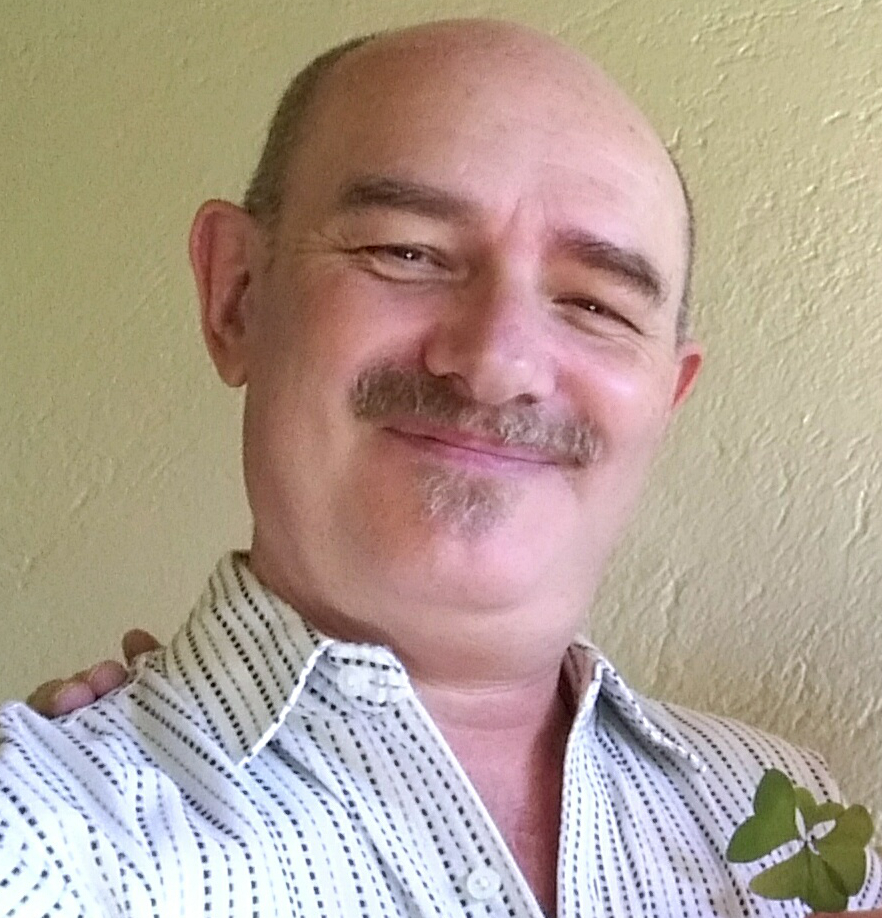
His original contributions to the development of the CRYSTAL program and more generally to solid state computational chemistry are countless: in the mid 90s he formally developed and implemented the use of symmetry-adapted crystalline orbitals for SCF-LCAO periodic calculations within the Hartree-Fock and Density-Functional-Theory frameworks, which allows to efficiently exploit point-symmetry and drastically reduce the computational cost of such demanding calculations; he devised a scheme for localizing crystalline orbitals into Wannier functions in a periodic LCAO scheme; he worked at the implementation of many options of the geometry optimizer, of vibrational features such as infrared intensities and LO/TO splitting of solids; he developed an original scheme for the transition-state search in periodic systems, and many others. For the upcoming CRYSTAL17 version of the program, he recently implemented a scheme for the evaluation of Hirshfeld charges. He authored more than 130 papers published in international journals.
Beside being an excellent quantum-chemist and a beautiful person, Claudito (as we all used to call him) was family. Because of his human and empathic character he has never just been a colleague or collaborator but rather a caring son, brother, uncle, father to many of us during all these years.
His day-by-day work on the program will be deeply missed by all of us as well as his irony, his Argentinian humor, his colorful shirts and tasteful hats, the sound of his guitar.
Hasta siempre Claudito
CRYSTAL14 (v1.0.4)
The CRYSTAL Team is pleased to announce the release of CRYSTAL14 v1.0.4 (released on 26/04/2016).
Version 1.0.4 is mainly a bugfix release.
All users are encouraged to upgrade to v1.0.4 as soon as possible.
This is the list of options which have been fixed in the v1.0.4 version of CRYSTAL14:
- Electronic band structure for open-shell systems (asymmetric k-points only)
- Piezoelectricity of 1D and 2D cases (non-periodic directions fixed)
- Piezoelectricity for open-shell systems
- BREAKELAST option restored
- ATOMINSE+SUPERCELL combination fixed
- Cell gradients for charged systems
- Range-separated hybrids (conflict with bipolar approximation fixed)
- Some static limits for CLUSTER option have been relaxed
- Small fixes (normalization, k-points coordinates) in phonon bands and density-of-states
- CUBE format for 3D plots of charge density and electrostatic potential fixed
- Various fixes in restart options of vibration frequencies + IR and Raman intensities calculation
- HJS exchange hole for open shell systems. This affects HSE06, HSEsol, HISS, LC-wPBE, LC-wPBEsol and LC-wBLYP functionals.
- Fixes in the POTC option
Obituary - Roberto Orlando (1961-2016)
Our dear friend and colleague Roberto Orlando passed away prematurely, after a long and courageous battle against cancer, on April 19, 2016 at the age of 55.

Since his M.Sc. degree, Roberto has been developing and applying theoretical quantum mechanical methods for the ab initio study of the electronic structure of solids. He was one of the main developers of the CRYSTAL code. His contribution in this respect has been invaluable. He organized and was a speaker at numerous international schools on ab initio modelling of solids over the years. His passion for research and teaching was recognized by his international colleagues and students.
Beside being an excellent scientist, Roberto has always been a sweet and caring person.
CRYSTAL14 (v1.0.3)
The CRYSTAL Team is pleased to announce the release of CRYSTAL14 v1.0.3 (released on 03/09/2014).
Version 1.0.3 is mainly a bugfix release.
All users are encouraged to upgrade to v1.0.3 as soon as possible.
This is the list of options which have been fixed in the v1.0.3 version of CRYSTAL14:
- Calculation of IR intensities and Piezoelectric tensor in MPP (massive parallel) mode
- Phonon dispersion for 1D systems
- Scan over internal coordinates
- PREOPTGEOM and BUNITSDECO options in the FREQCALC block
- Electronic band structure for systems without symmetry
- Combination of Raman intensities and Grimme correction
- Iterative optimization of atomic coordinates and cell
- Piezoelectric constants for 1D systems
- Calculation of X-ray structure factors with shrinking factor set to 1
- LC-wBLYP functional
- Combination of ROTREF and PPAN options
CRYSTAL14
The CRYSTAL Team is pleased to announce the release of CRYSTAL14 (v1.0.1)
The new version of CRYSTAL is available and can be downloaded from the CRYSTAL solutions web site
CRYSTAL14 is a major release and the most relevant new features are:- Static first- and second-hyperpolarizability and the corresponding electric susceptibilities tensors through a Coupled Perturbed HF/KS scheme
- Improved phonon dispersion calculation (phonon band structure and DOSs, ADPs and Debye-Waller factors, ...)
- Raman and IR intensities through a CPHF/KS approach
- Automated calculation of the piezoelectric and photoelastic tensors of crystalline systems
- New DFT functionals: mGGA, Range-separated hybrids and Double-hybrids
- Automatic generation of fullerene-like structures
- New tools to model low-dimensionality systems (nanorods, nanoparticles, ...)
- New tools for the treatment of solid solutions
- Improved Massive-parallel version (MPPcrystal - distributed memory)
- Internal interface to CRYSCOR for electronic structure calculations of 1D,- 2D- and 3D-periodic non-conducting systems at the L-MP2 correlated level and Double-Hybrids
- Internal interface to TOPOND for topological analysis of the charge density
CRYSTAL09 v2.0.1
The CRYSTAL Team is pleased to announce the release of CRYSTAL09 v2.0.1
Version 2.0.1 is mainly a bugfix release.
All users are encouraged to upgrade to v2.0.1 as soon as possible.
Binaries and objects
CRYSTAL09 for Unix/Linux/MacOSX is supplied as binary executables or object files for a number of supported architectures (see http://www.crystal.unito.it/platforms.html). Precompiled executables include sequential (crystal, properties) and replicated data parallel version (Pcrystal). The massive parallel version (distributed memory) is only supplied as object files.
Not all binary executables are available to be downloaded, yet.
To avoid compatibility problems with pre-compiled binaries, users are kindly invited to compile executables by starting from object files.
This allows one to link specific MPI libraries for parallel execution.
How to download CRYSTAL09 v2.0.1
- Users who registered at the CRYSTAL registration web site can download the code at the following links:
- http://www.crystalsolutions.eu/login.html
Registered users can access to the download area by using the registered user's e-mail address as login and the password they received when the license purchase was finalized. - http://www.crystal.unito.it/download09 (no longer available)
Registered users can access to the download area by using login/password details they received when the license purchase was finalized.
- http://www.crystalsolutions.eu/login.html
- Users who registered at the CRYSTAL Solutions web site can download the code by using their account details
List of changes
Here is a list of the main changes in v2.0.1 as compared to v1.0.1.
Geometry optimization
The algorithm has been changed when a step yields an increase in the total energy. The calculation of the gradients is now skipped until the total energy decreases.
Vibrational frequency calculation
- A new option has been added (i.e. NEGLEFRE) to allow users to remove the first n-th vibrational modes in the calculation of thermodynamic functions.
- When using SCELPHONO/DISPERSION thermodynamic quantities are now referred to the primitive unit cell.
GRIMME's empirical dispersion correction (option GRIMME)
A bug has been fixed in the Grimme's correction for the cell gradients of non-orthogonal Bravais lattices.
Elastic constants calculation (keyword ELASTCON)
The code for the calculation of elastic constants has been deeply revised.
Thanks to Elisa Albanese and Alessandro Erba for helping in revising the code.
- Fixed a printing error for triclinic systems
- Fixed a problem with non-primitive monoclinic systems
- Removed a bug with hexagonal/rhombohedral crystals
- The restart option has been modified to make it more stable and flexible. Calculations can be restared from any deformation and the number of points can be increased as well. For instance, a 5-point calculation can start from a previous 3-point calculation
We apologize for any inconvenience.
Configuration counting and cluster expansion
Due to a bug of the code, in the CONFCOUNT option the DATAFORFIT, SOLSOL and MAGNET keywords have been disabled.
Work is in progress to fix the bug.
New web site for registration and download of CRYSTAL/CRYSCOR
From December 2012, the CRYSTAL and CRYSCOR codes are distributed through Aethia srl, a small company that represents an interface (denoted as Crystal Solutions) to CRYSTAL and CRYSCOR users.
The new web site is: www.crystalsolutions.eu
Ordering, payments, download, installation, advice about hardware and other activities unrelated to the use and development of the code will be available through the new web site.
This will allow users to have:
- a faster management of purchase orders and requests
- increased security in personal data handling and money transfer
- an up-to-date professional technical knowledge of hardware and web publishing, where Aethia srl owns a great experience
All registered CRYSTAL09 users can access to the new web site through the following link by using their e-mail address and password.
New support form for CRYSTAL/CRYSCOR users
Support to CRYSTAL users is supplied through the new web site. Users can submit questions by filling the Support Request Form
There are three types of requests:
- Administrative/Commercial issues: for supporting users with administrative questions (e.g. registration, quotation, payment, invoice, ...) and download of the codes
- Technical Support CRYSTAL: to help CRYSTAL users with problems related to execution, errors, input,...
- Technical Support CRYSCOR: to help CRYSCOR users with problems related to execution, errors, input,...
Awards
The Theoretical and Computational Chemistry of the Italian Society of Chemistry has established the "Cesare Pisani" Gold Medal in memory of our colleague who died in 2011. The medal is awarded to scientists who are advanced in the field of Theoretical and Computational Chemistry.
The CRYSTAL Team is proud to announce that Prof. Roberto Dovesi is the recipient of the 2012 "Cesare Pisani" Gold Medal of the Italian Society of Chemistry for his ability to combine top level scientific rigor and technical skills that allowed him to optimally lead the development of one of the most well-known computational tools for solid state chemistry and physics.
Obituary - Cesare Pisani (1938-2011)
Our dear friend and colleague Cesare Pisani died on July 17, 2011.
Born in 1938, he graduated in Physics in 1963 at the University of Milano. His career took place in the University of Torino, where he became full professor in Quantum Chemistry in 1981. In 2009, he was awarded the title of Emeritus Professor of the University of Torino.
Throughout his scientific activity, he has been one of the leaders of the Theoretical Chemistry Group of the University of Torino. For almost forty years he has been developing and applying theoretical quantum mechanical methods for ab initio study of the electronic structure of solids. His pioneering developments have been implemented in the computer codes: CRYSTAL, EMBED and CRYSCOR, now extensively used by the solid state community throughout the world.
His scientific contribution in the computational quantum chemistry and physics is invaluable. In addition to his outstanding professional qualities, Cesare has been a wonderful and caring person. We owe him a debt of gratitude for his friendship and patient guidance.
All those who have worked and interacted with him, all his friends, colleagues and students, will deeply miss him.
Obituary - Carla Roetti
Carla Roetti has died on September 7, 2010.
She graduated in chemistry (1967) at the University of Torino, where she became Associate Professor in Physical Chemistry in 1980.
Throughout her scientific activity, she has been one of the leaders of the Theoretical Chemistry Group of that University. For almost forty years she has been involved with her colleagues in the quantum mechanical ab initio study of the electronic properties of solids and in the implementation of related algorithms and computer codes, in particular of CRYSTAL.
Her contribution in this respect has been invaluable. Since the release of the first public version of CRYSTAL (1988) and throughout all the subsequent ones, she has had a leading role in caring the maintenance, the full portability, the documentation and testing of the new features of the code, and the support to the users.
All those who have worked and interacted with her will deeply miss her.
Obituary - Alessio Meyer
Alessio Meyer was a second year PhD student of the Theoretical Chemistry Group in Torino, when he suddenly and unexpectedly died on 23/12/2009.
He was a dear friend to all of us, and a most valuable scientific collaborator.
An account of his activity in our group is reported here.
